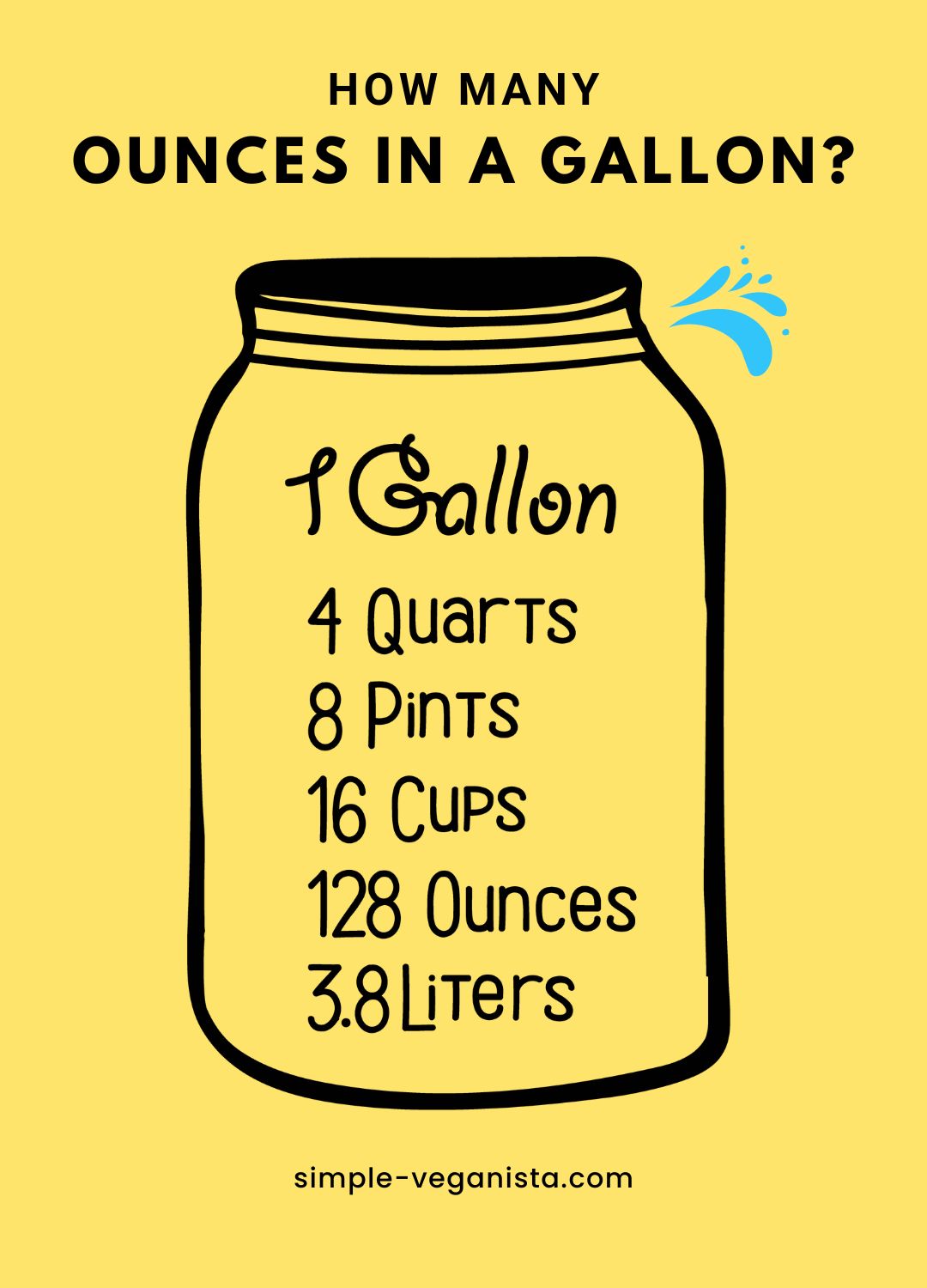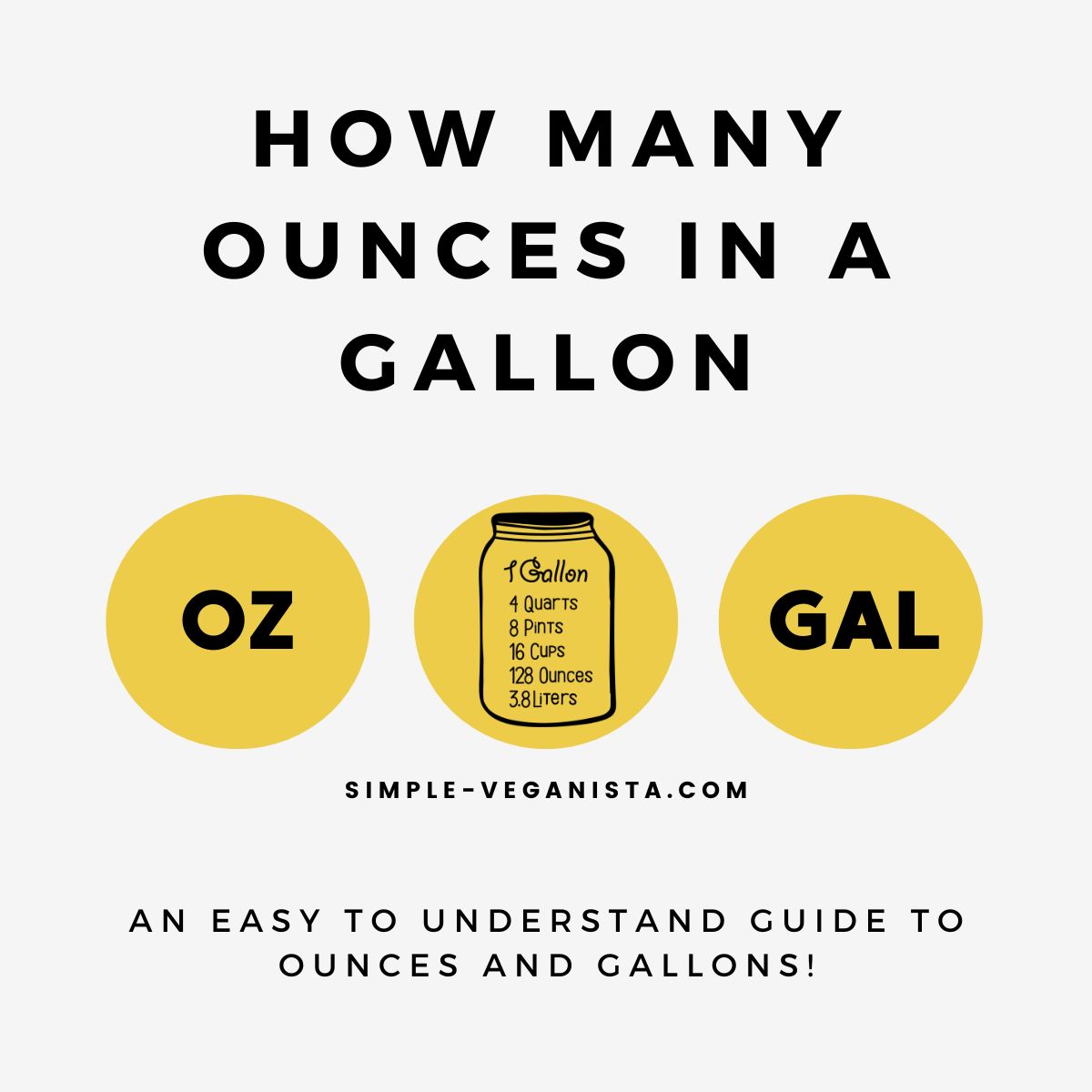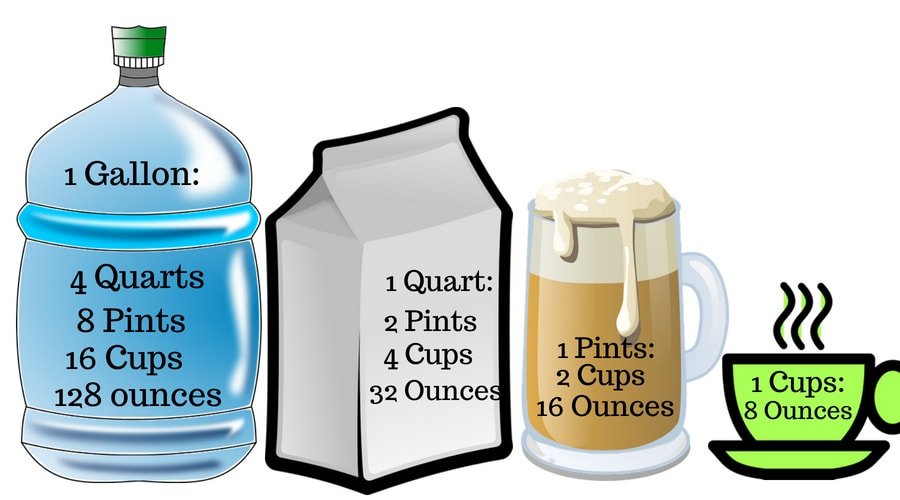How Many Ounces In A Gallon - A Simple Guide
Ever found yourself scratching your head when a recipe calls for a certain liquid amount, or perhaps you are just curious about how much liquid a big container actually holds? It's a pretty common situation, that. Knowing how much liquid fits into a gallon, especially when we talk about ounces, can really make a difference, whether you are in the kitchen, dealing with household projects, or simply trying to figure out fuel consumption for a vehicle. This seemingly straightforward question, how many ounces in a gallon, actually has a couple of different answers depending on where you are on the globe. It's a little bit like asking for the time; you need to know the time zone, so too it's almost the same with liquid measurements.
The way liquids are measured can vary quite a bit from one place to another, and this can sometimes lead to a bit of confusion. What one country calls a gallon might not be the exact same volume as what another country calls a gallon. This is particularly true when you look at the United States and the United Kingdom, where their systems for measuring liquid amounts, including gallons and ounces, have developed along different paths. So, when you are trying to work out how many ounces are in a gallon, it is really helpful to first figure out which measurement system you are looking at.
Getting a good grip on these differences can save you a lot of guesswork and potential mistakes, especially if you are working with instructions or products that come from different parts of the world. It is not just about knowing a number; it is about knowing which number applies to your specific situation. This guide aims to clear up some of that mystery, giving you a clearer picture of liquid volumes and how they are sized up in various contexts, just a little bit of helpful information for your everyday needs.
Table of Contents
- How Many Ounces in a Gallon - Understanding the Basic Difference
- What's the Deal with Liters and How They Relate to Ounces?
- How Many Ounces in a Gallon - Exploring Broader Liquid Conversions
- Why Does Oil Conversion Require Extra Information About How Many Ounces in a Gallon?
- How Many Ounces in a Gallon - Considering Cups and Their Ounce Counts
- Converting Liquid Volume to Weight - How Many Ounces in a Gallon by Weight?
- The Imperial Gallon and US Gallon - A Closer Look at How Many Ounces in a Gallon
- Is There a Simple Way to Calculate Water Weight and How Many Ounces in a Gallon?
How Many Ounces in a Gallon - Understanding the Basic Difference
When you start looking into how many ounces are in a gallon, the very first thing that pops up is that there isn't just one single number. It turns out that a gallon of water, or any liquid really, holds a certain amount of fluid ounces, but this amount changes depending on whether you are using the system common in the United States or the one used in the United Kingdom. In the United States, a gallon of water contains 128 fluid ounces. This is a pretty standard measurement that most people in the US are familiar with for things like milk, gasoline, or even large containers of juice.
On the flip side, if you are in the United Kingdom, a gallon of water holds a different quantity altogether. There, a gallon measures 160 fluid ounces. That is a noticeable difference, nearly 25% more liquid in a UK gallon compared to a US gallon. The main reason for this variation is simply that the US and the UK use different ways of sizing up their gallons and their fluid ounces. These systems developed separately over time, and they just ended up with different definitions for what a "gallon" truly means. It is sort of like how some places drive on the left side of the road and others on the right; it is just a different established custom, you know?
This difference is more than just a bit of trivia; it has real-world implications. If you are following a recipe from a British cookbook while living in the US, or vice versa, you could end up with a very different result if you do not adjust for these varying liquid amounts. For instance, if a UK recipe calls for a gallon of milk, and you use a US gallon, you would be short on the liquid, which could really mess up the texture of what you are making. So, when you ask how many ounces in a gallon, it is crucial to remember which country's measurement you are thinking about, just to be sure.
What's the Deal with Liters and How They Relate to Ounces?
Beyond gallons and ounces, many products, especially those from outside the US, are measured using liters. This is part of the metric system, which is widely adopted around the world. So, it is pretty useful to know how liters stack up against ounces, particularly US fluid ounces, since that is a common conversion point for many people. One liter, for instance, is equal to 33.814 US fluid ounces. This is a handy number to keep in mind if you are ever looking at a beverage bottle that only lists its volume in liters and you want to get a sense of its size in a more familiar measurement.
Let's say you have a slightly larger quantity, like one and a half liters. If you are trying to figure out how many ounces that amounts to, the calculation is pretty straightforward. One and a half liters is equal to 50.721 US fluid ounces. This kind of conversion comes in handy quite often, especially when you are dealing with international products or recipes that might use metric measurements exclusively. It is a bit like translating a language; you need to know the equivalent words to make sense of things.
Knowing these liter-to-ounce conversions, especially for US fluid ounces, helps bridge the gap between different measurement systems. Many tools and charts exist that are specifically for liter-to-ounce conversions in the US system, making it easier to quickly switch between these two ways of describing liquid volume. It helps a lot to have these figures at your fingertips, or at least know where to find them, when you are trying to work with various liquid amounts.
How Many Ounces in a Gallon - Exploring Broader Liquid Conversions
Liquid volume isn't just about gallons, liters, and ounces; there is a whole collection of other units that people use, depending on what they are measuring or where they are located. For example, you might come across barrels, which are often used for oil or other large industrial quantities, or cubic feet, which are more common in engineering or construction. Then there are smaller, everyday measurements like pints, which you might see for beverages, or even tablespoons, used in cooking.
Because there are so many different ways to measure liquid, converting from one unit to another can sometimes feel a bit like a puzzle. Luckily, there are many tools available that are specifically made to help with these sorts of liquid volume conversions. These tools let you instantly switch between various metric and imperial liquid volume units, making it much simpler to figure out how much liquid you actually have, no matter what unit it is expressed in. It is pretty useful, actually, to have something that can do that work for you.
So, whether you need to convert from liters to US gallons or UK gallons, or if you are trying to figure out how many pints are in a barrel, these liquid volume converters can be a real help. They take the guesswork out of it, allowing you to focus on what you are doing rather than getting bogged down in arithmetic. It is about making things easier, so you can quickly get the answers you need for how many ounces in a gallon, or any other liquid measure.
Why Does Oil Conversion Require Extra Information About How Many Ounces in a Gallon?
When you are talking about converting liquids, especially something like oil, it gets a little more involved than just figuring out how many ounces are in a gallon. The thing with oil, and many other substances, is that their weight can vary quite a bit even if the volume stays the same. This is because different types of oil, or even different batches of the same oil, can have different densities. Density is basically how much "stuff" is packed into a given space. A very dense liquid will weigh more per gallon than a less dense liquid.
So, if you want to convert a volume of oil, like a certain number of gallons, into a weight, such as pounds or ounces, you absolutely need to know the substance's density figure. Without that specific piece of information, any conversion from volume to weight would just be a guess. For example, a gallon of motor oil will not weigh the same as a gallon of olive oil, because their densities are different. It is a bit like comparing a gallon of feathers to a gallon of rocks; they take up the same space, but their weight is very, very different.
This is why specialized oil conversion tools often ask for or provide a list of common oil types along with their typical densities. This helps ensure that when you are trying to figure out the weight of a certain amount of oil, you are getting an accurate result. It really highlights that for some conversions, just knowing how many ounces in a gallon isn't enough; you also need to consider the specific properties of the liquid itself.
How Many Ounces in a Gallon - Considering Cups and Their Ounce Counts
Moving from gallons to smaller measurements, cups are a very common unit, especially in cooking and baking. But even with cups, there is a small detail that can sometimes trip people up: the difference between dry ounces and fluid ounces. When you are measuring liquids, you typically use fluid ounces. A standard US cup, for instance, holds 8 US fluid ounces. This is pretty straightforward for water, milk, or any other liquid ingredient.
However, when you are measuring dry ingredients like flour, sugar, or oats, you might sometimes see recipes that refer to "dry ounces." This is where it gets a little different. Dry ounces are a measure of weight, not volume. So, while a cup of water will always be 8 fluid ounces, a cup of flour will weigh a different number of dry ounces than a cup of sugar, even though they both fill the same volume of a cup. This is because flour and sugar have different densities, just like different types of oil.
Understanding this distinction is pretty important for getting your recipes right. If a recipe calls for "8 ounces of flour," it almost certainly means 8 dry ounces (by weight), not 8 fluid ounces (by volume). Trying to measure flour by fluid ounces would be like trying to measure a solid block of cheese with a measuring cup designed for liquids; it just doesn't work the same way. So, when you are thinking about how many ounces in a gallon, or even how many ounces in a cup, remember to consider whether you are talking about liquid volume or dry weight.
Converting Liquid Volume to Weight - How Many Ounces in a Gallon by Weight?
It is one thing to know how many ounces are in a gallon by volume, but sometimes you need to know how much a gallon of something actually weighs. This conversion from volume to weight is very useful for many things, like shipping, storage, or even just understanding the physical properties of different liquids. The weight of a gallon will change depending on the specific liquid you are considering. For example, a gallon of water will weigh a certain amount, but a gallon of milk, petrol, or oil will each have a different weight.
Water is a good starting point for these kinds of conversions because its density is pretty consistent and well-known. A US gallon of water, for instance, weighs approximately 8.34 pounds. The reason for this specific weight has to do with the density of water itself. Water is a fairly dense substance, and that density determines how much a given volume of it will weigh. This is why you often find reference charts and conversion calculators that specifically deal with converting gallons to pounds for various liquids.
These tools are very helpful because they take into account the unique density of each liquid. So, if you are wondering how much a gallon of milk weighs compared to a gallon of gasoline, these resources can give you the precise figures. It is about more than just knowing how many ounces in a gallon; it is about knowing the actual mass that those ounces represent when they are filled with different substances.
The Imperial Gallon and US Gallon - A Closer Look at How Many Ounces in a Gallon
We touched on this earlier, but it is worth taking a moment to really emphasize the distinction between the US gallon and the Imperial gallon, which is used in the UK and some other Commonwealth countries. This difference often comes down to what you might call "the small print" of measurement systems. It is not just a slight variation; they are fundamentally defined differently. The US gallon came about from an older English wine gallon, while the Imperial gallon was established much later in the UK, based on the volume of 10 pounds of water.
This historical divergence means that when someone mentions a "gallon," it is not always immediately clear which version they are referring to without additional context. The US gallon holds 128 fluid ounces, as we know, while the Imperial gallon holds a full 160 fluid ounces. This means an Imperial gallon is roughly 20% larger than a US gallon. So, if you are reading an old British recipe or looking at fuel efficiency figures from a car made for the UK market, you need to keep this size difference in mind. It is a subtle but very significant detail that can change your calculations quite a bit.
Understanding that "US gallons are different to the Imperial gallon" is a pretty important piece of knowledge for anyone dealing with international measurements. It highlights why simply asking "how many ounces in a gallon" needs that extra clarification about which gallon system is being used. It is a classic example of how different standards can exist side-by-side and require careful attention to avoid mistakes or misunderstandings.
Is There a Simple Way to Calculate Water Weight and How Many Ounces in a Gallon?
Given all the different units and the variations between systems, it is natural to wonder if there is an easy way to figure out the weight of water, especially when you are dealing with common liquid volumes like gallons, liters, cups, or tablespoons. Fortunately, there are tools specifically designed for this purpose, often called water weight calculators. These are pretty handy because they take the guesswork out of converting liquid volume to weight.
These calculators allow you to input a volume of water, whether it is in gallons, liters, cups, or tablespoons, and then convert that volume into various weight units, such as pounds, ounces, grams, or kilograms. This is incredibly useful for a range of activities, from cooking and baking where precise ingredient weights are important, to larger projects where you need to know the total weight of a large quantity of water. It is about making the process as straightforward as possible, you know?
So, if you are ever curious about how much a gallon of water weighs, or if you need to convert a smaller amount like a cup of water into grams for a recipe, these water weight calculators are the way to go. They provide quick and accurate conversions, helping you manage liquid quantities with confidence. It is a good way to ensure you are always getting the right measurements, no matter the unit you start with or the unit you need to end up with, including how many ounces in a gallon.
This exploration has covered the varying amounts of ounces in a gallon, distinguishing between US and UK measurements, and looked at how liters connect to ounces. We also touched upon the broader world of liquid volume conversions, the unique considerations for converting oil due to density, and the differences between dry and fluid ounces in a cup. Furthermore, we discussed how to convert liquid volumes to weight for various substances, the historical reasons behind the differing US and Imperial gallons, and the utility of water weight calculators for everyday needs.

How Many Ounces in a Gallon? (Conversion Guide & Charts!)

How Many Ounces in a Gallon? (Conversion Guide & Charts!)

How many Ounces in a Gallon